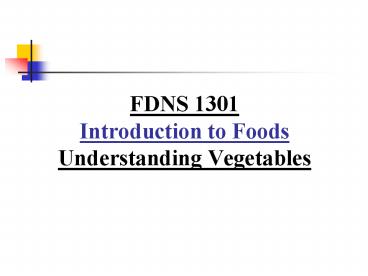FDNS 1301 Introduction to Foods Understanding Vegetables - PowerPoint PPT Presentation
1 / 19
Title:
FDNS 1301 Introduction to Foods Understanding Vegetables
Description:
4) fruits (tomato) 5) roots (carrot) 6) tubers (potato) 7) flowers (cauliflower) ... acid and overcooking turns to dull olive green (pheophytin) ... – PowerPoint PPT presentation
Number of Views:93
Avg rating:3.0/5.0
Title: FDNS 1301 Introduction to Foods Understanding Vegetables
1
FDNS 1301Introduction to FoodsUnderstanding
Vegetables
2
Vegetable Composition
- based upon classification type
similar to fruit water
carbohydrates increased cellulose (fiber)
3
Classification or Types of Vegetables
- 1) leaves (lettuce)2) stems
(celery)3) bulbs (onion)4)
fruits (tomato)5) roots
(carrot)6) tubers (potato)7)
flowers (cauliflower)8) seeds (green
peas)
4
Selection Characteristics
- dependent on structure type
color smell or odor weight
mold free clean or debris free
check stem end
5
Storage Concerns
- washing refrigeration
temperature and moisture - want to prevent water loss
revitalize by soaking in cold water
6
Color Concerns
- 1. Solubility in Water2. Effects of
Cooking3. Effects of Acids4. Effects of
Alkali5. Effects of Metals
7
(No Transcript)
8
Types of Pigments
9
Chlorophyll
- makes carbohydrates in plants
stored in chloroplasts (slightly insoluble) - acid and overcooking turns to dull olive
green (pheophytin) alkali turns to bright
green (chlorophyllin) - increased solubility and poor taste
10
Caratenoids
- normally yellow/orange and sometimes red
or pink slightly insoluble in water
acid reduces the pigmentation alkali has
no effect long cooking may reduce the
intensity of color
11
Anthocyanins
- red, purple or blue colors very
water soluble acid turns pigment
red alkali turns pigment purple or
blue metal ions (tin or iron) turns it
violet or blue
12
Betalain
- purple red or yellow very water
soluble exposure to acid will make it
slightly brighter red - Exposure to alkali will shift red to yellow
- becomes pale when overcooked
13
Anthoxathin
- also known as flavones or flavonols
white or colorless very soluble in
water acid turns it white alkali
turns it yellow long cooking times darken
the pigment and sometimes turn it pink
iron turns it dark aluminum turns it
bright yellow
14
Flavor ComponentsCabbage
- sulfur compounds (sinigrin) when cut break down
to mustard oil overcooking heightens
process
15
Onions
- when cut, sulfur and enzymes react to irritate
eyes and nose
16
Potatoes
- green parts from solanine (bitter alkaloid)
17
Cooking Preparation
- trim washing peeling
18
Changes during Cooking
- 1. gelatinization of starch granules2.
kill microbes3. loss in chemicals4.
oxidize vitamins5. increased water absorption
(diffusion and osmosis)6. mechanical losses
from agitation, overcooking, paring7. fiber
changes (alkali softens, acid has no effect)
19
Dried Legumes
- must be cooked proteins
available gelatinize starch
increased flavor decreased toxic
substances increased water and cellulose
breaks down































